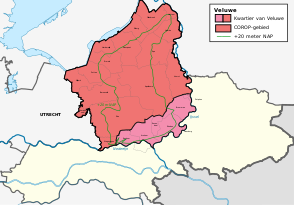
Back فيلواه Arabic Veluwe Catalan Veluwe Czech Veluwe Danish Veluwe German Veluwe Spanish Veluwe French Feluwe Frisian Veluwe ID Veluwe IO
Veluwe | |
|---|---|
Region | |
| Area | |
| • Total | 912 km2 (352 sq mi) |
| Population (2023) | |
| • Total | 715,729 |
| Website | https://www.visitveluwe.nl/ |


The Veluwe (Dutch pronunciation: [ˈveːlyu.ə] ) is a forest-rich ridge of hills (1100 km2; 420 sq. mi.) in the province of Gelderland in the Netherlands. The Veluwe features many different landscapes, including woodland, heath, some small lakes and Europe's largest sand drifts.
The Veluwe is the largest push moraine complex in the Netherlands, stretching 60 km (40 miles) from north to south, and reaching heights of up to 110 metres (360'). The Veluwe was formed by the Saalian glacial during the Pleistocene epoch, some 200,000 years ago. Glaciers some 200 metres (600') thick pushed the sand deposits in the Rhine and Maas Delta sideways, creating the hills which now form most of the Veluwe. Because the hills are made of sand, rain water disappears rapidly, and then it flows at a depth of tens of metres (yards) to the edges where it reaches the surface again.[1]
Originally the Veluwe was surrounded by a string of swamps, heavily populated with game such as deer and wild boar because these areas offered rich vegetation to feed on. Since the 1990s many plans are underway, or have already been implemented, to restore these wetlands by blocking the drainage systems built by farmers during the last 150 years. This results in very dry heathland changing into wetland within a span of just a few hundred metres (yards). The Wisselse Veen near the village of Epe, on the northeastern Veluwe, offers a good example of this.[citation needed]
© MMXXIII Rich X Search. We shall prevail. All rights reserved. Rich X Search


